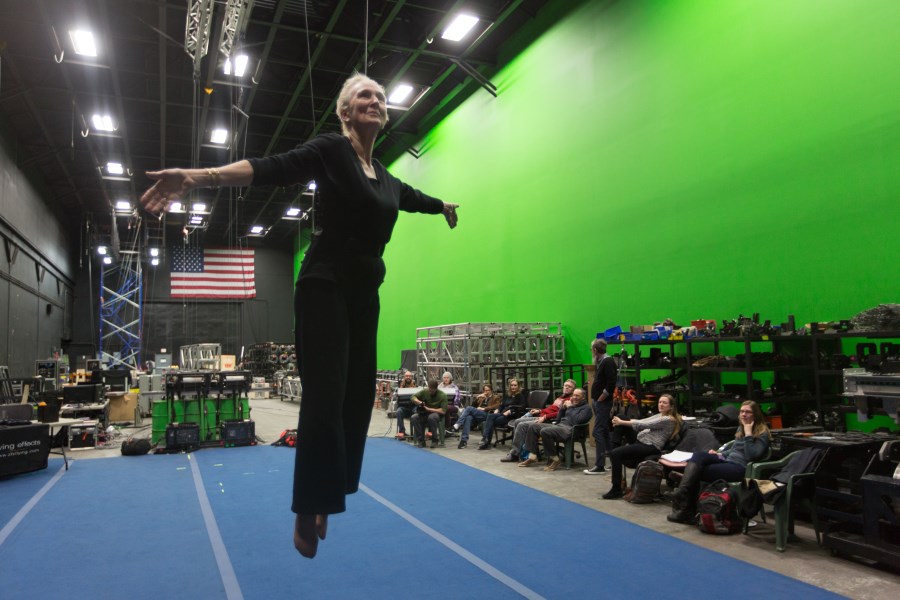“And if it means I must prepare
To shoulder burdens with a worried air,
I’ll never grow up, never grow up, never grow up…”
—Carolyn Leigh, from the 1954 musical Peter Pan
When is a person truly a grown-up? Is it when they get a real job, when they have a child of their own, when their parents die? Is “never” really an option?
These questions are at the heart of Sarah Ruhl’s For Peter Pan on her 70th birthday, which takes the tale of the boy who never grew up for a new spin while telling a story about something we all have in common: death.
For Peter Pan, which ran March 8-April 10 as part of Actors Theatre of Louisville’s Humana Festival of New American Plays, was inspired by Ruhl’s mother, Kathleen, who played the character onstage as a teenager, and who is seen on the poster for the play looking perky in her green costume.
“When I was growing up, whenever I visited her family house in Iowa, there were these pictures of her as Peter Pan, in green tights, flying,” Ruhl recalled. “So it was part of my association with my mother, and also part of my association with what theatre was.”
The play opens with a 70-year-old Ann (Kathleen Chalfant), a sort of stand-in for Ruhl’s real-life mother, directly addressing the audience about the joy of performing the role as a child. Ann is the oldest of five, with three brothers and a younger sister, all of whom are dealing in different ways with the impending loss of their father.
Ruhl tells the story in three “movements” without an intermission: First is the vigil at the hospital; then the informal, whiskey-fueled wake around the kitchen table; and finally a fantasy sequence in which the siblings jump into the world of Peter Pan—or rather, a children’s play version of Peter Pan, but with their creaky knees and bad eyesight.
To make the final part work, some technology would be necessary—you can’t do Peter Pan with everybody’s feet on the ground. Louisville happens to be the home of ZFX Flying Effects, a company that handles everything from building equipment and harnesses to aerial choreography for productions around the world. (Cirque du Soleil, for one, gets all their black steel cables from ZFX, whose technicians developed a coloring process that makes wires invisible onstage.)
“I had always thought the flying would be a metaphor and we wouldn’t actually be able to afford flying one character, much less five, around the stage,” Ruhl admitted. But director and longtime collaborator Les Waters—whose first order of business when he took over as ATL’s artistic director in 2012 was to commission a new play from her—had other ideas. He told Ruhl, “Oh, we’re flying them.”
Because the script in the fantasy section calls for the characters to fly rather suddenly, the actors couldn’t be taken offstage to clip into their flying lines. So the decision was made to allow the mechanics of flying to be seen, along with other elements of the stagecraft.
“Seeing those moments then allowed us to make the general decision that the crew can be seen manipulating and setting scenery and props whenever necessary during the metatheatre parts of the play,” said scenic designer Annie Smart.
Brian Owens, senior flying director and lead trainer at ZFX, worked with the creative team to determine where and how the flying effects would work. While Owens has worked on massive productions, including the Arabic version of “American Idol,” For Peter Pan allowed him to work on a much smaller scale.
“The biggest challenge was coming up with a way to tell the story so that the flying effects supported the rest of the script and didn’t just become this thing we did,” explained Owens. “It was really just this artistic process, this collaborative art form that I so dearly love, of saying, ‘Well, what about this idea?’ or ‘What if we change this moment a little bit?’ It doesn’t matter where those ideas come from, whether it was me or Les or Sarah.”
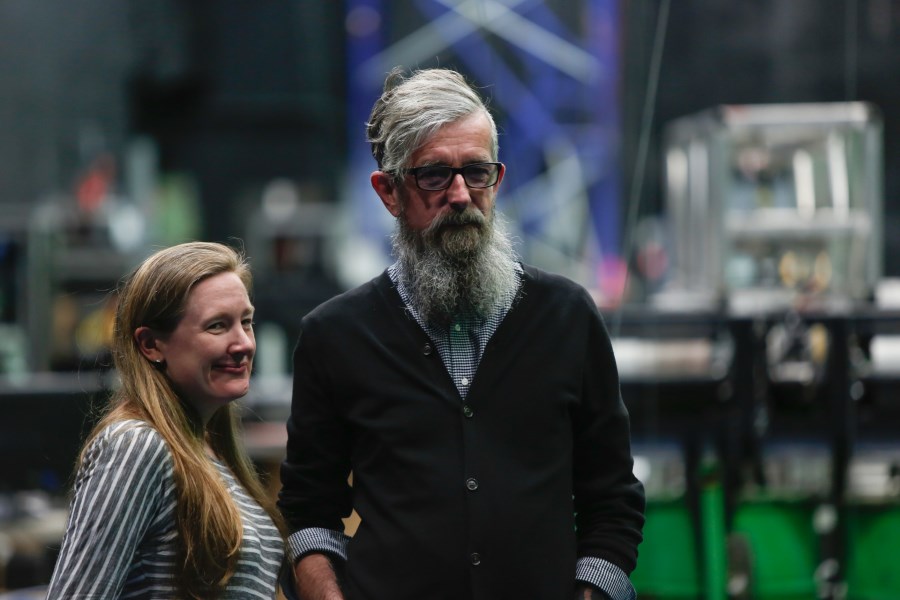
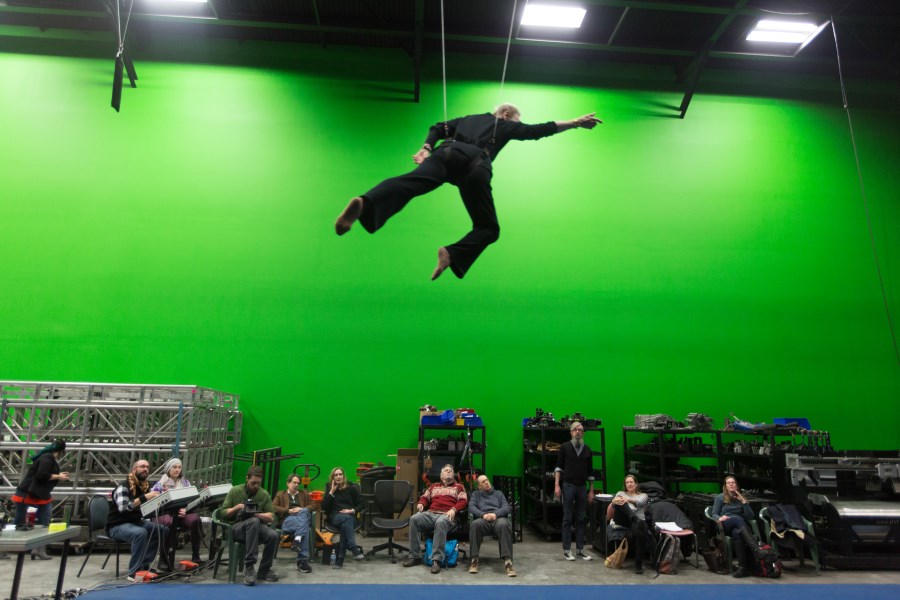
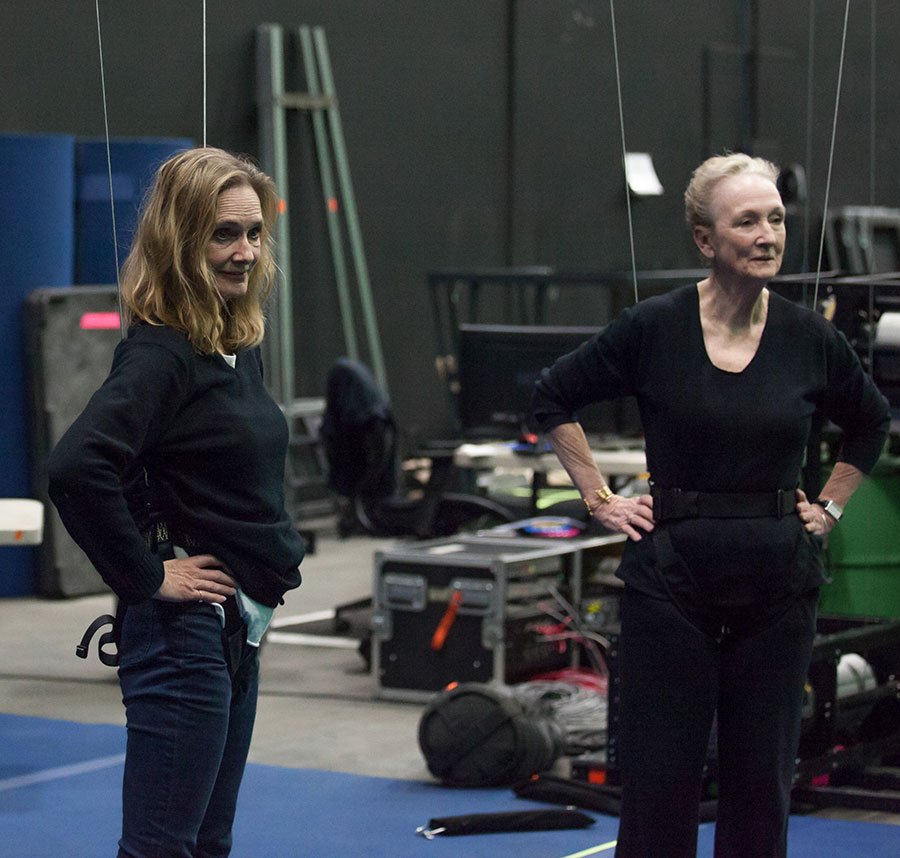
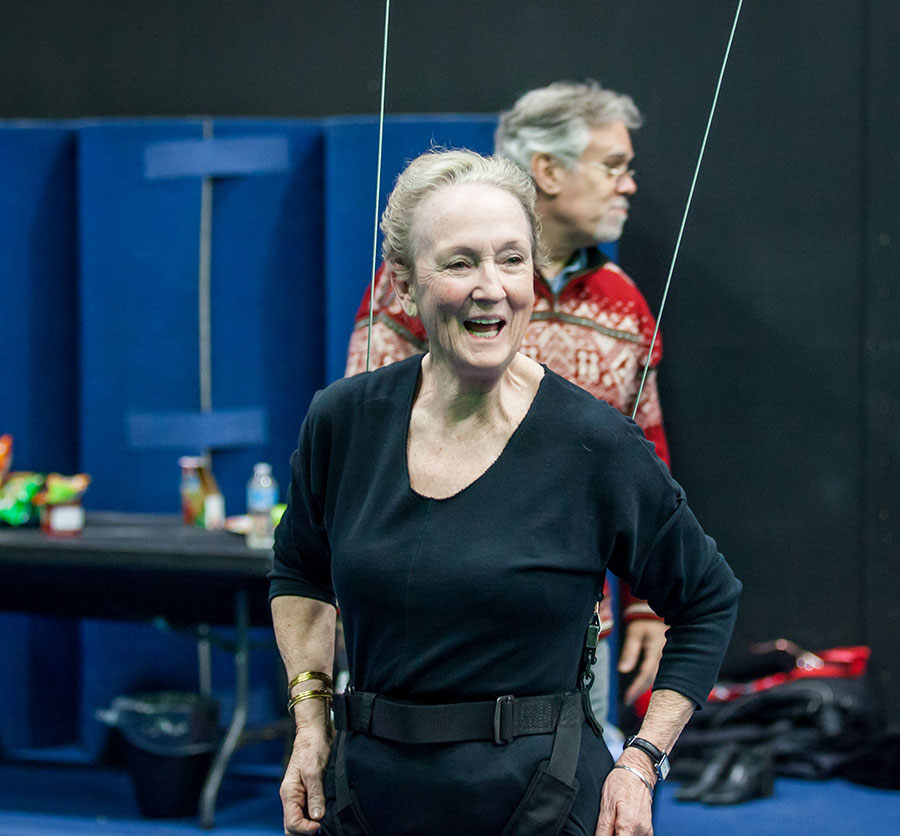
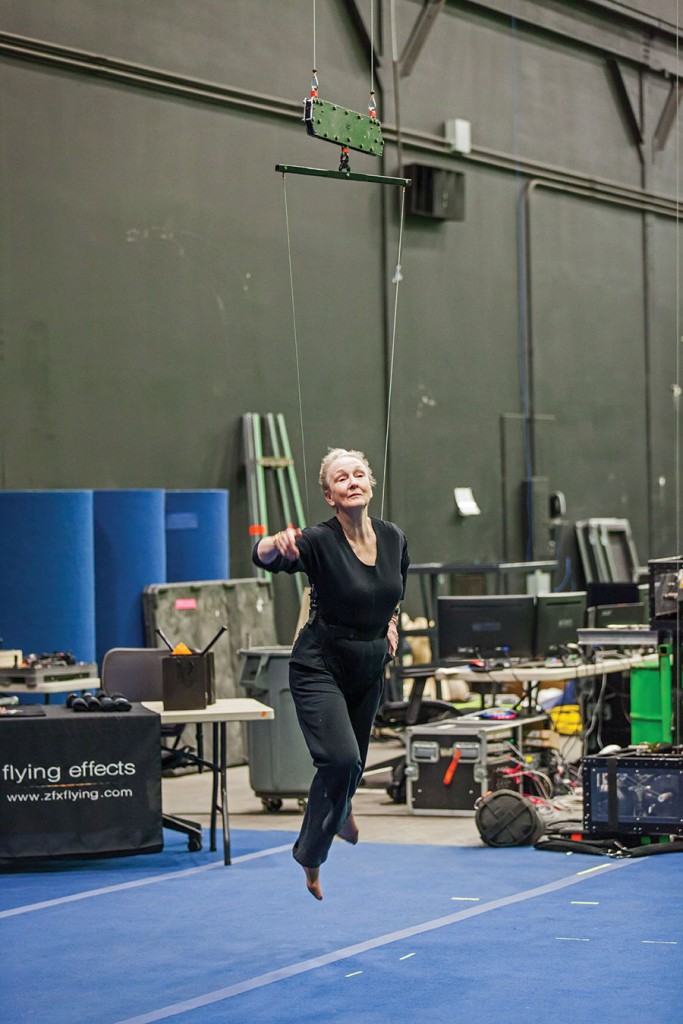
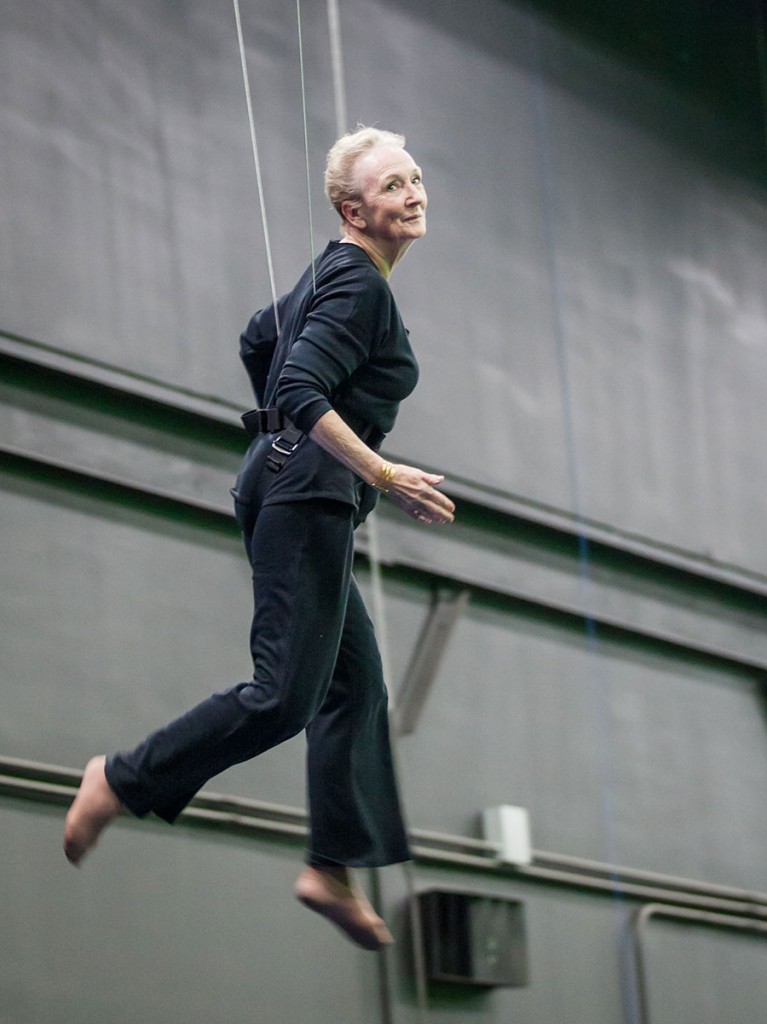
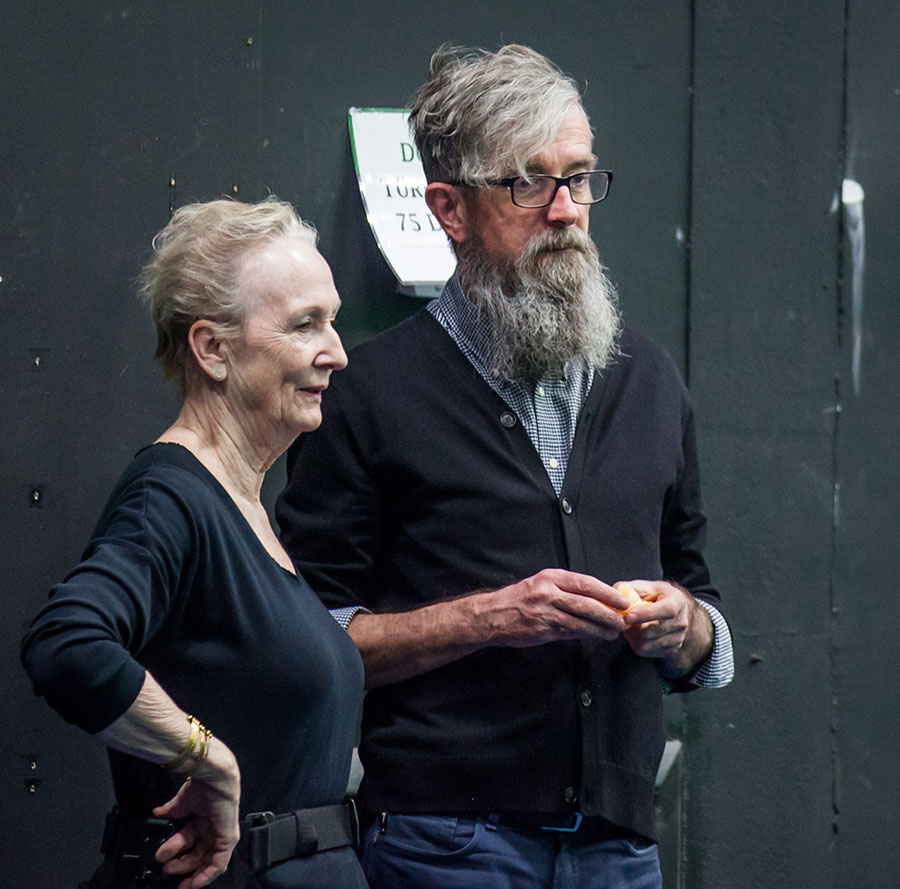
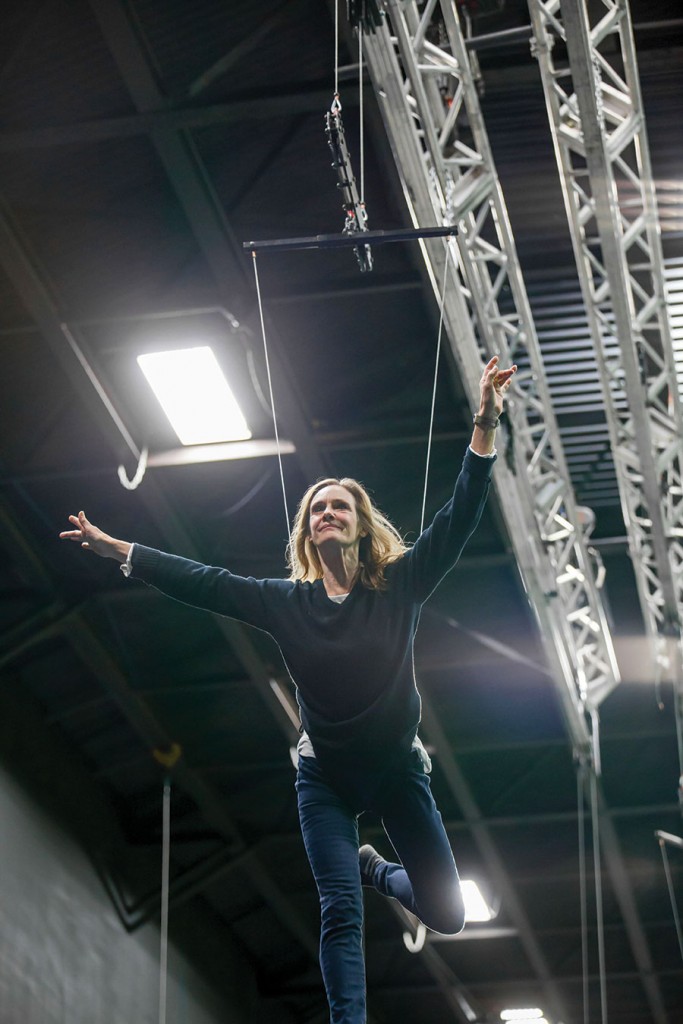
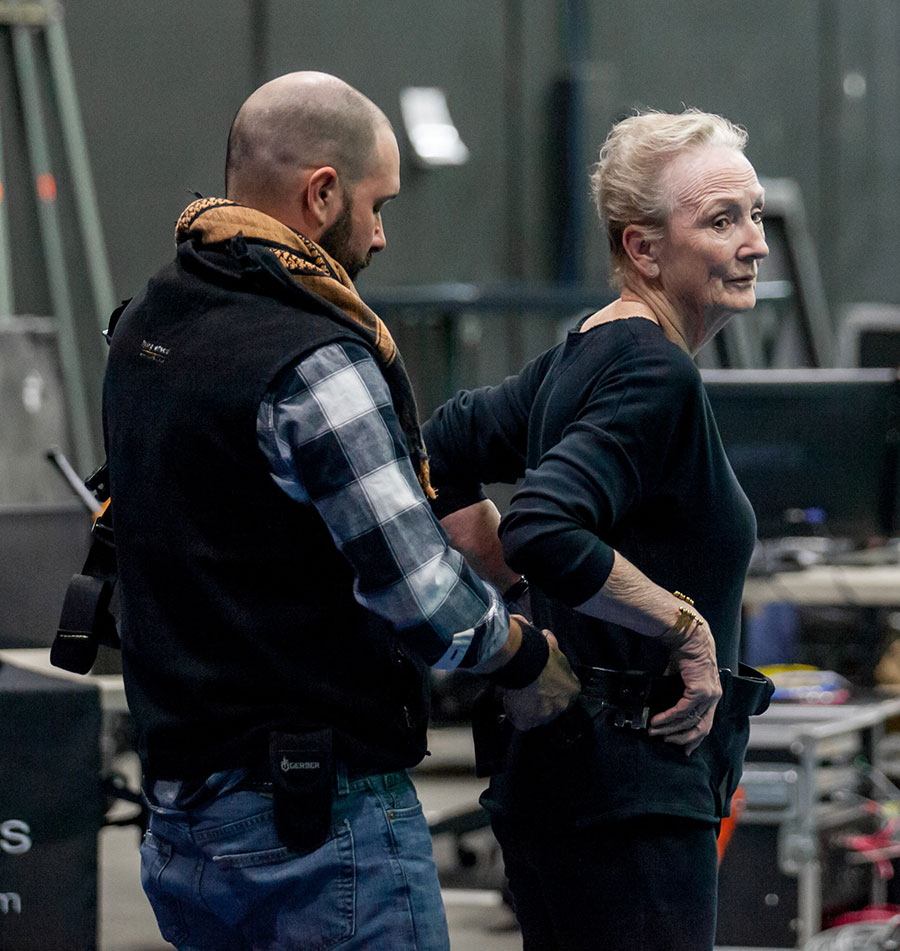
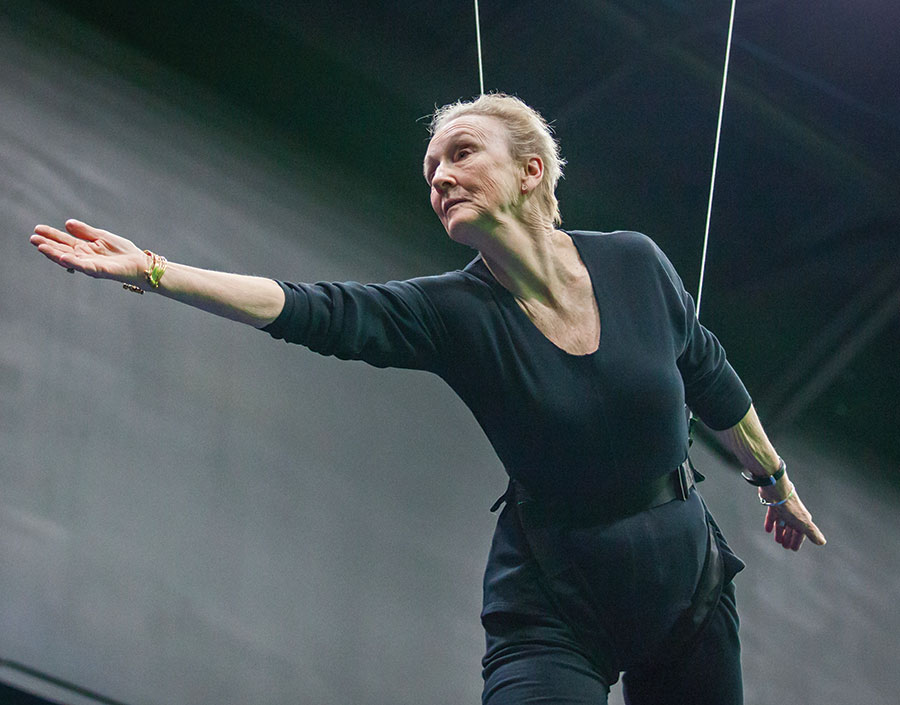
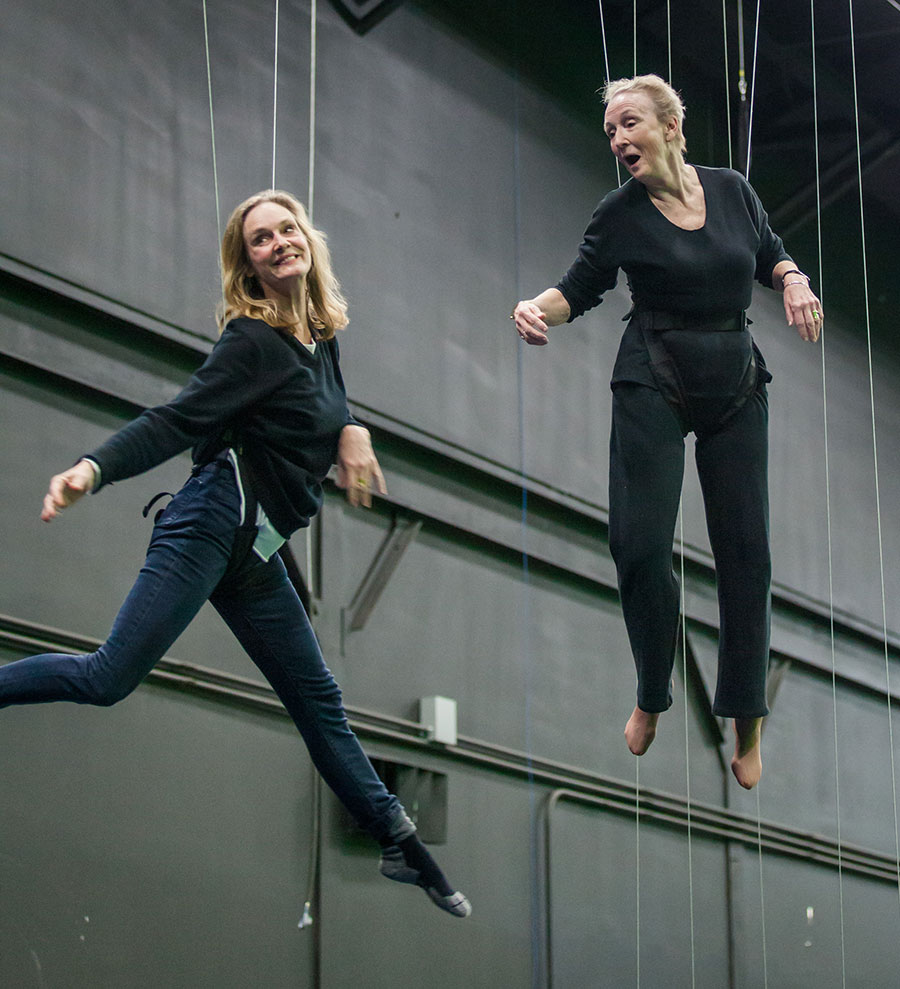
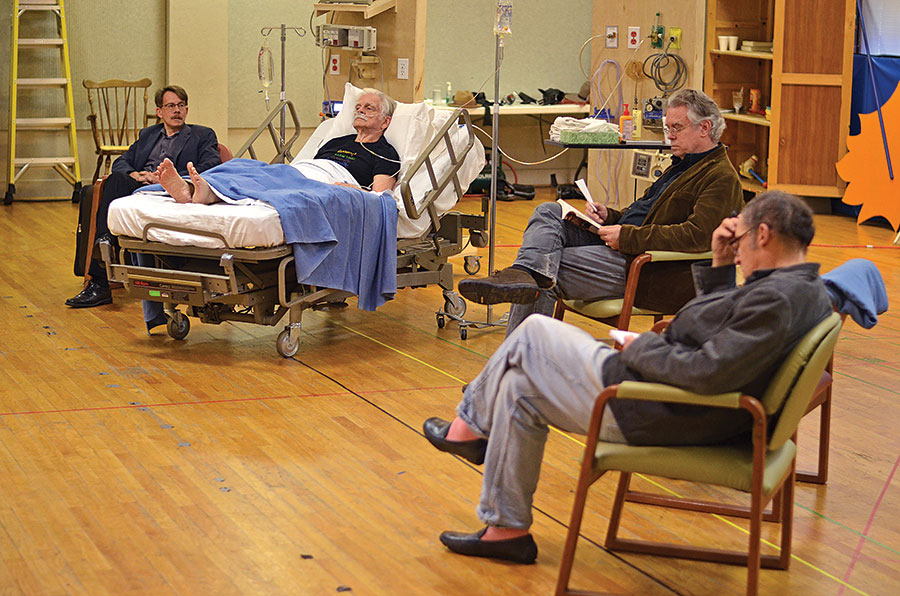
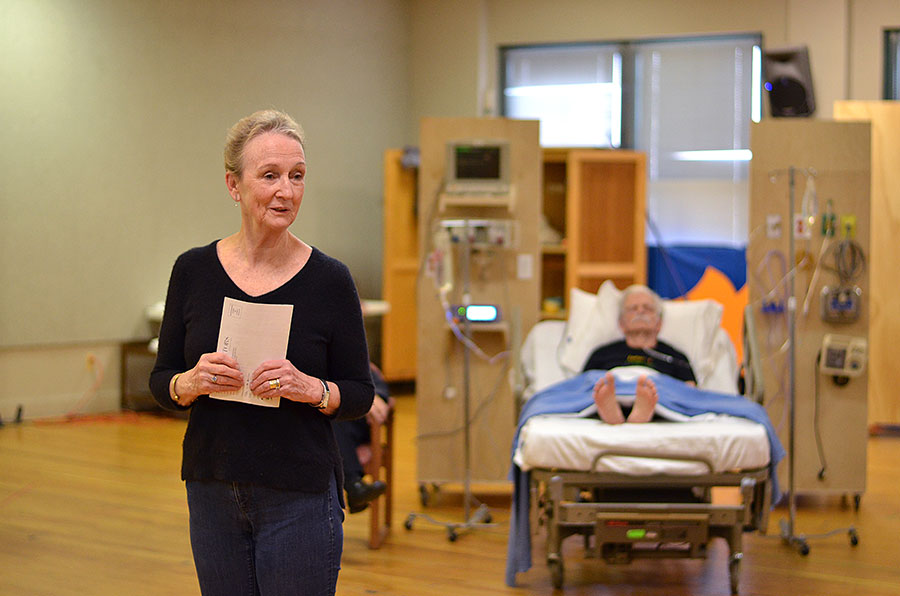
In January, most of the cast gathered at ZFX’s cavernous rehearsal space for some flying practice. Chalfant and Lisa Emery, who played younger sister Wendy, were the only two actors who would wear harnesses and fly in the production; both said that the opportunity to fly was a huge draw for them to do the play. Chalfant had never flown onstage before, though she spent years in the role of Hannah Pitt being jealous of the Angel in Angels in America.
“It’s sort of everything you imagine it will be, and it feels absolutely safe,” said Chalfant, after coming down from pirouetting 15 feet in the air. “It’s one of those things that’s only fun.”
“Except when you’re trying to turn,” added Emery, laughing. She described the experience of flying as “ecstatically beautiful.”
Meanwhile, though the brothers—played by Scott Jaeck, Keith Reddin, and David Chandler—didn’t fly individually, they did clamber onto a bed that became a pirate ship and was hoisted aloft.
The play’s initial read-through also marked the first official day of work on the 2016 Humana Festival, as the entire Actors Theatre staff, along with a few donors and volunteers, gathered in the rehearsal room for a kickoff and family photo. There was a festive feeling as everyone introduced themselves. When it was Ruhl’s turn, she said simply, “I’m Sarah and I wrote the play,” and the room burst into applause.
Surveying the energetic whirl as the space was being set up for the reading, Ruhl said, “There’s something surreal about writing a play in your solitary room, and then there’s all these people and dogs.” (A canine in the play’s second section is triple-cast.)
Another production of For Peter Pan would go up May 20-July 3 at California’s Berkeley Repertory Theatre, with the same cast save Emery and Jaeck, who had other commitments. “The wonder of doing a new play in a theatre like Actors Theatre, and knowing that it will go on to Berkeley, is that there’s a long period of development,” said Chalfant. “A play like this, which on the page looks quite simple, is in production going to be pretty complex. And it’s wonderful to know that you have the time to realize it.”
At first glance it does look pretty straightforward on the page: lots of silence amid ongoing conversations, mostly good-natured family meandering, all the characters in one room together. But then you may notice some of the details Ruhl tosses in:
- A suggestion that the siblings might “form a ragtag five-piece band with trumpet and accordion and sing and play ‘When the Saints Go Marching In,’” or a marching band might enter, at the end of the first section. In Louisville, actual marching bands—six different local high school bands taking turns over 20 performances—were hired to perform the song as the set changed behind a classic red velvet curtain.
- The aforementioned dog—the ghost of the family pet, to be precise. In the production the role was assayed by a rotating cast made up of a golden retriever, an Irish wolfhound, and an English sheepdog. The sheepdog was fired after a few shows for sleeping on the job, but the golden did so well she landed another role, as Crab in The Two Gentleman of Verona, at Kentucky Shakespeare through August.
- A splashy sword fight between Peter Pan and Captain Hook in which Peter is slain, then revived by audience applause, in a neat twist on the Tinkerbell tradition.
- As we said: flying.
In short, For Peter Pan isn’t as simple as it may seem. For one, as Smart noted, the entire design had to factor in the flying from the beginning. What’s more, the differences between the three sections presented a design challenge.
“In many ways, Sarah has written something she imagines very pared back—a studio show, a black-box event, something intense and intimate—for parts one and two of the play,” Smart said. “And then within that, she imagines the sudden and delightful appearances of traditional stage curtains and flying drops—the trappings of an old-fashioned touring house.”
Smart built a two-walled hospital room using rolling units that could then become the family home, creating the enclosed space of the first two movements. In part three, the walls cleared to make way for a giant nursery window, creating a more expansive-feeling fantasy sequence while paying homage to the traditional Peter Pan aesthetic.
Lighting designer Matt Frey also chose to approach the first two sections differently. “We were trying to start in a very real place as much as possible, and then show signs of de-evolution as the play proceeds and shows its cracks of magic, humor, and nostalgia,” Frey explained. “By the end we are in a very different place than where we began.”
Actors Theatre’s Pamela Brown Auditorium has some built-in limitations that restricted what could be done: The grid ceiling is less than six feet above the lights, so a flying actor could not be lifted out of sight, nor could scenery be flown in. Adding to the complexity, at Humana For Peter Pan played in daily repertory with Wellesley Girl by Brendan Pelsue, the stage floor for which was installed beneath the floor for For Peter Pan—i.e., trap doors were also off-limits.
Flying complicated Frey’s job as the lighting designer as well. “You have performers moving on a whole new axis,” he said. “In addition to stage left/stage right and upstage/downstage, we now add up/down. So we try and account for that by addressing all the possibilities of where they might be.”
As director, Waters had some adjusting to do as well.
“How do you rehearse that in a rehearsal room, where you pretend somebody is 10 feet above somebody else?” Waters wondered. The answer: You just have to pretend until you can get into the theatre.
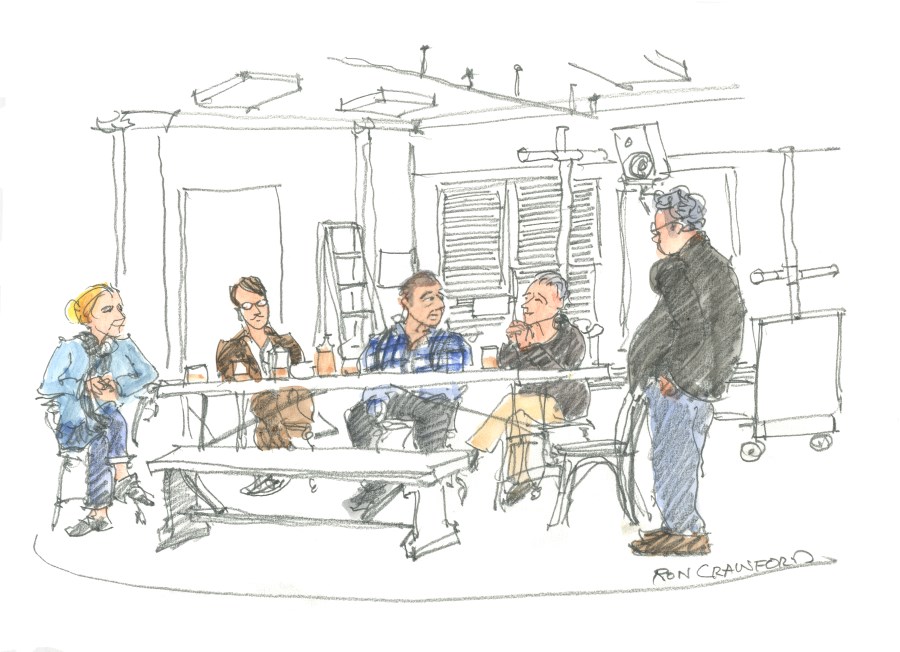
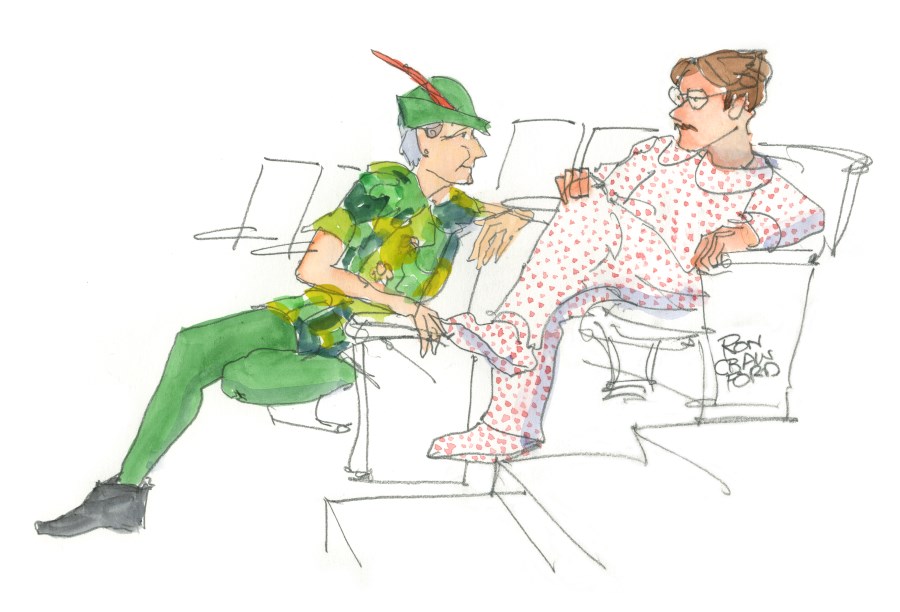
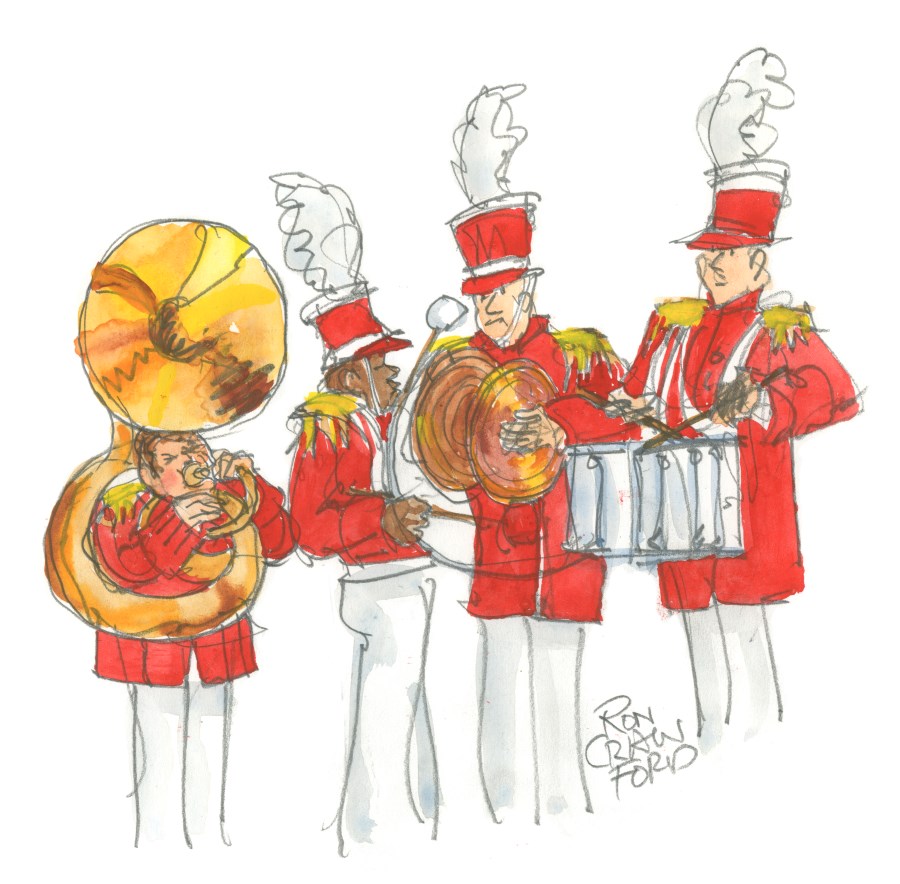
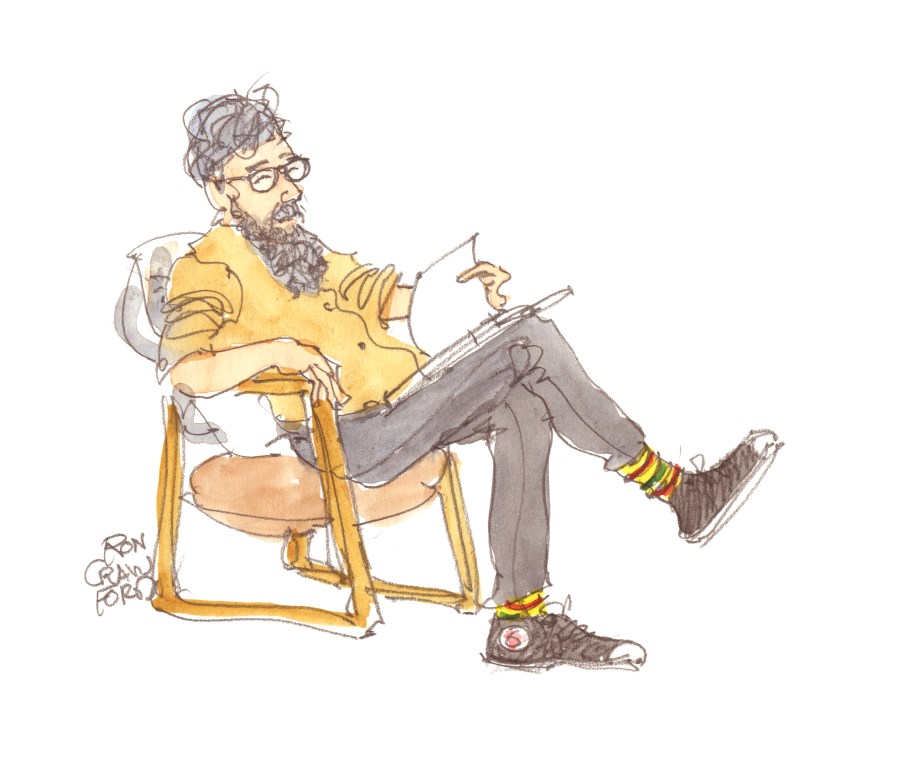
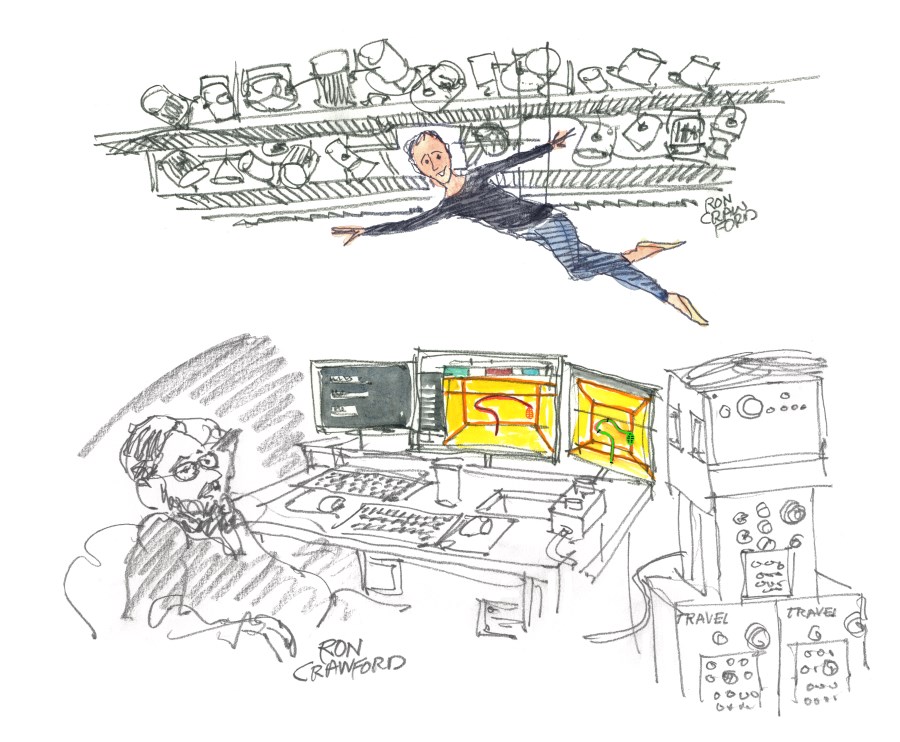
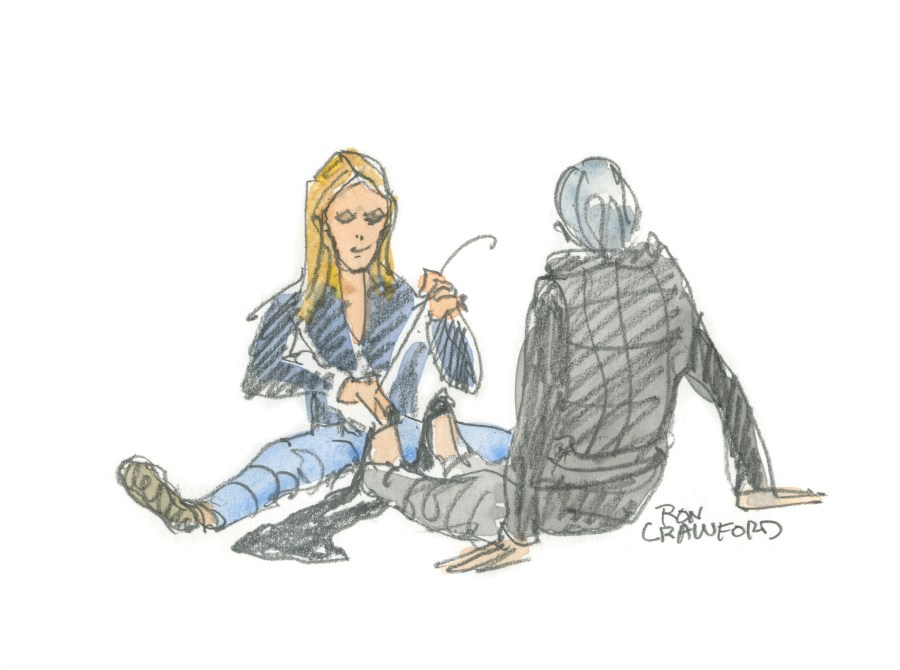
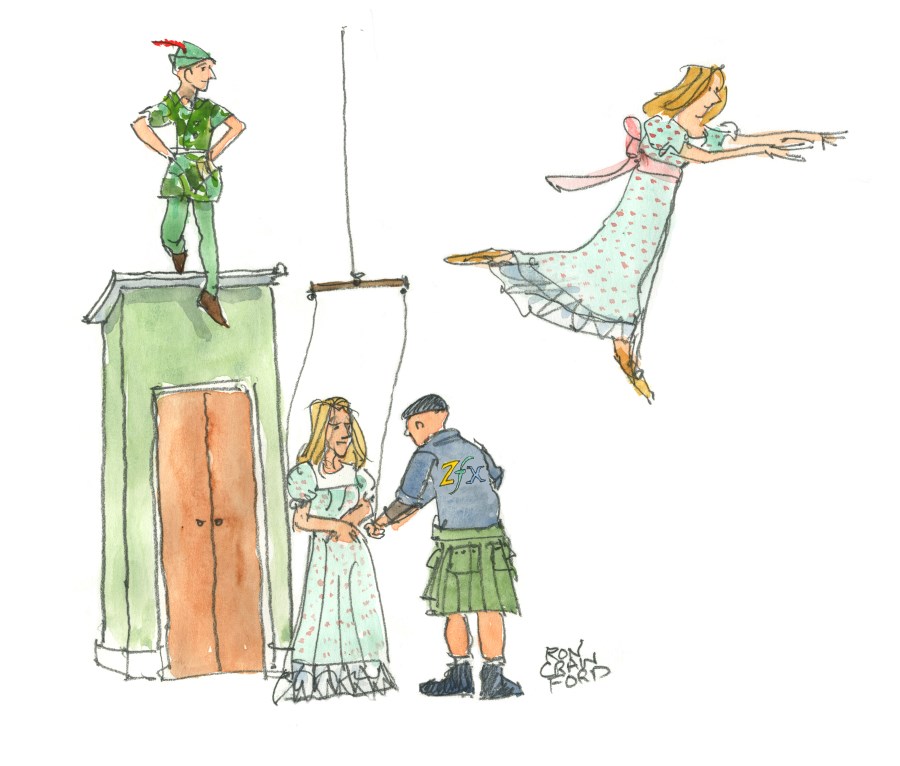
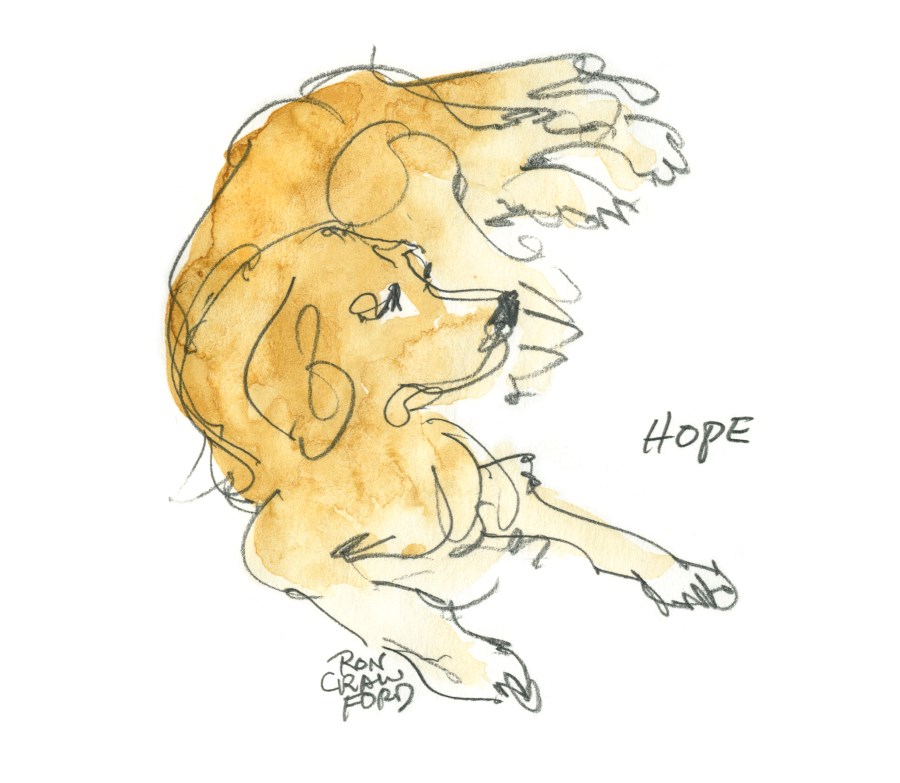
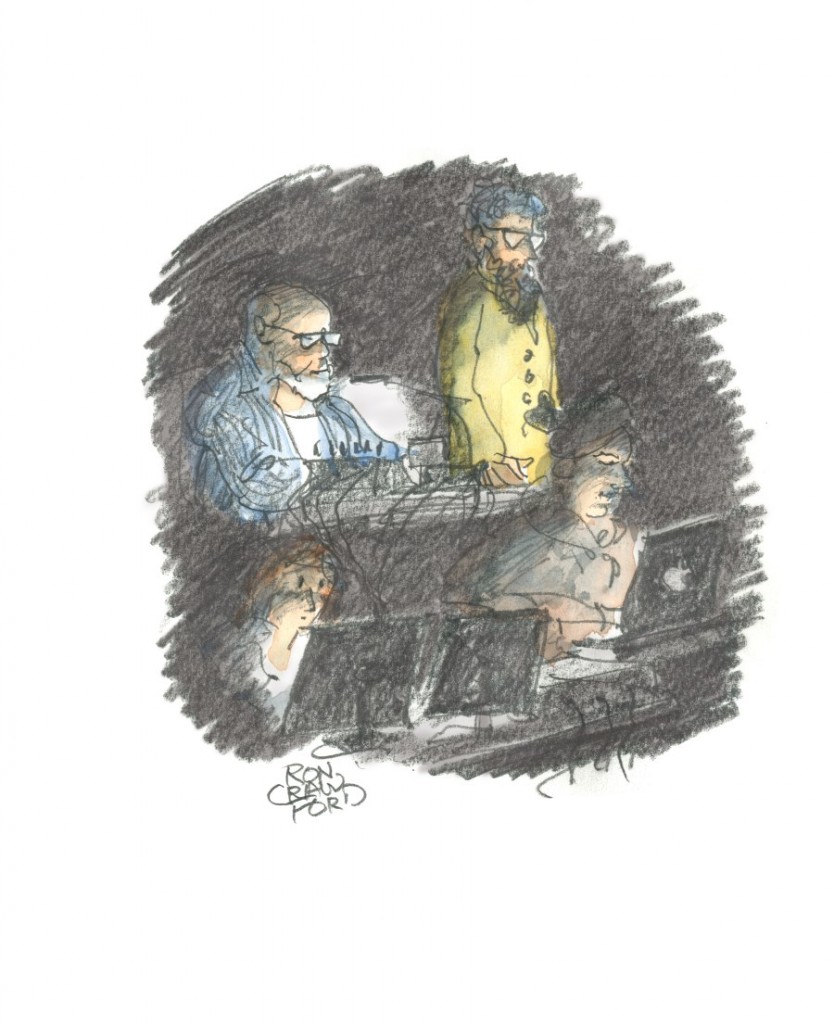
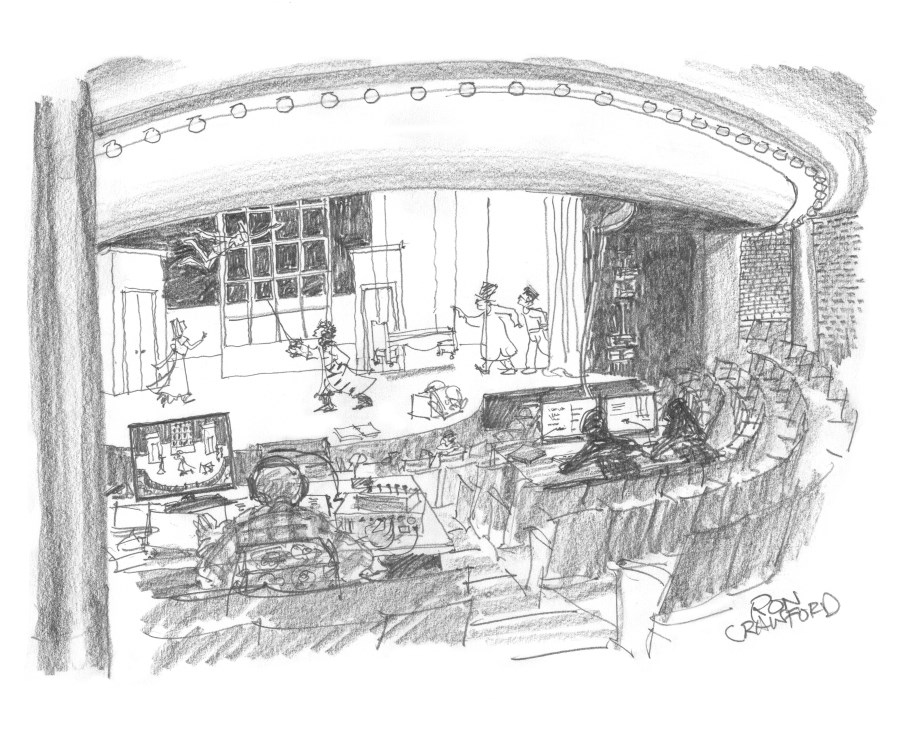
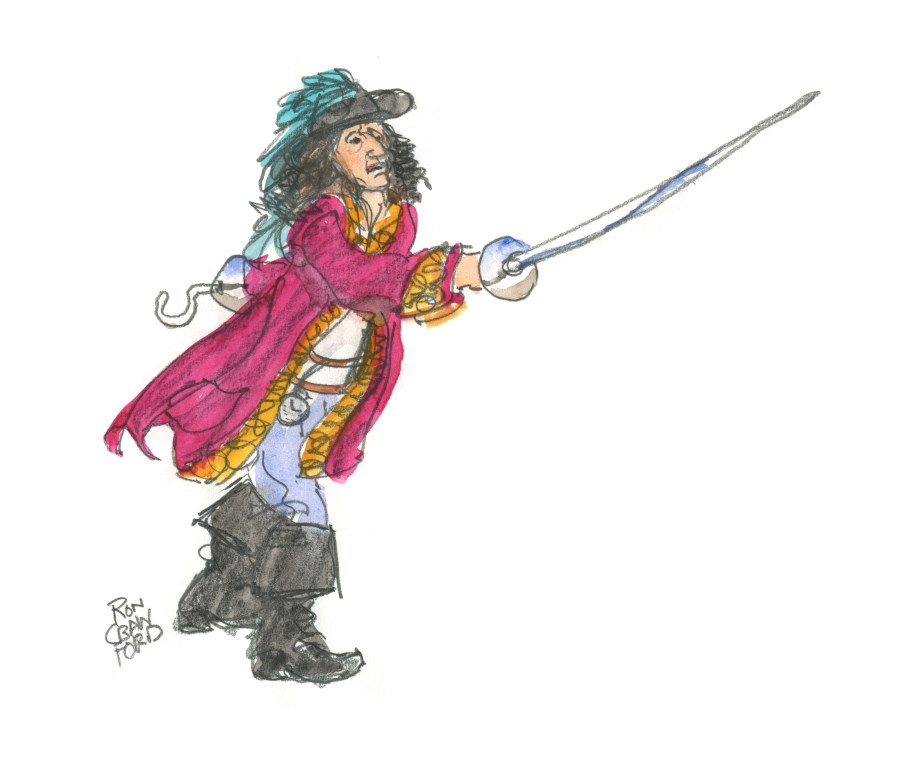
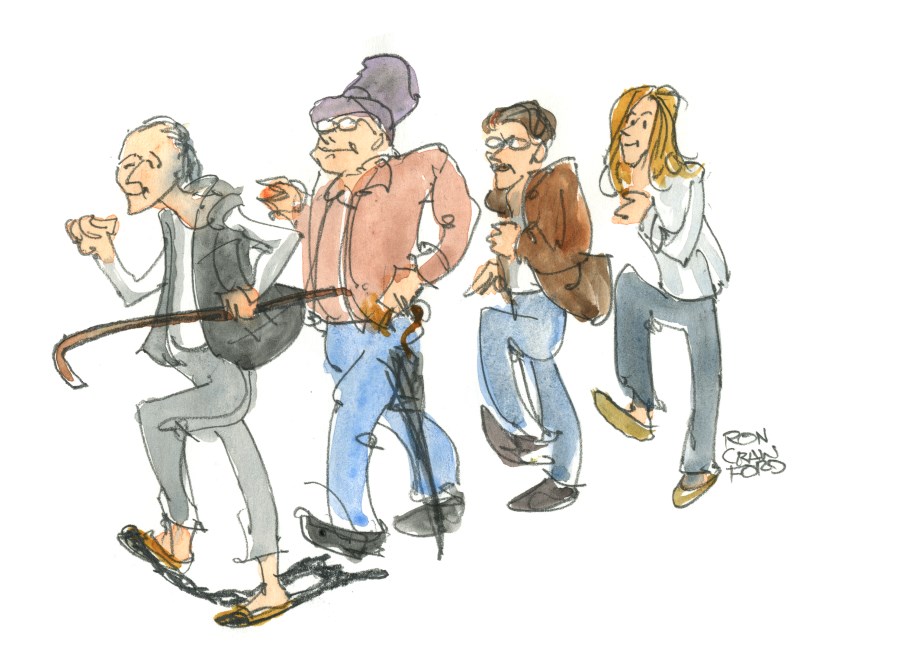
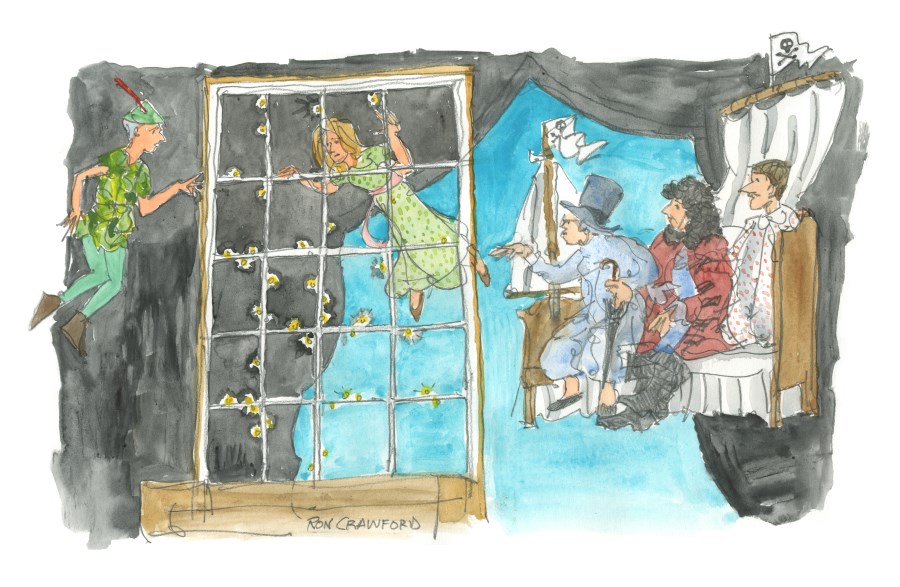
At a run-through about10 days before opening, the rehearsal space was packed with observers, including Actors Theatre’s troupe of acting apprentices. Even without costumes, sets, or a flying apparatus, the show had several observers openly weeping by the end. A burly twentysomething guy turned to me, a stranger, with tears in his eyes and asked for a hug.
When I shared this moment with Ruhl after the rehearsal, she said, “I think that anyone who’s lost someone in a family can relate, but I also think that for people who’ve been in theatre, it sort of ends up being a love note to what it means to work in the theatre. I think that’s partly what the tears are about.”
During rehearsals, before Chalfant even put on the famous Pan costume, she transformed into the classic character with her posture: back straight, chin up, one foot slightly in front of the other, arms akimbo. She is elegant and slim, with short hair, and she waggled her hips as a taunt to the lumbering Captain Hook.
In performance, Chalfant as Ann wore drapey pants and a loose sweater in the first two sections; the attentive observer might have seen a sliver of green above her short boots when she crossed her legs. But when she at last doffed her pants, revealing patchwork shorts and green tights, donned that iconic green cap with the red feather, and released a raucous crow call, the applause was spontaneous.
Most of the cast enjoyed hamming it up in the third movement, as the entire production took on a heightened feel, with underscoring (selected and arranged by sound designer Bray Poor) and sharper lighting. Frey described his lighting concept as “a place that is fantasy, memory, and a community theatre from over a half century ago—sometimes one of these things, and sometimes all.”
Ruhl said she wanted that section to feel as if the characters were putting on a children’s play, but also as if we’re going “into their dream life or their unconscious. They’re both children and adults at the same time.” Accordingly the characters shift between acting their parts as the Darling children and commenting on their “real” adult lives. In performance the contrast was both jarring and funny.
Smart’s set for this section was dominated by the huge nursery window, which she made even bigger than usual so that the adult performers looked a little smaller and more childlike. At the same time, the window piece was constructed to be extra-strong so that the flying actors could hold onto it and use it as a midstage anchor.
“The window represents light and dark, the home and family, escape from such, and later becomes a closed and locked gate—the adult ‘children’ return to look longingly through it at the old house, now sold and owned by another family,” Smart explained.
ZFX’s Owens said the moment when Wendy flies up behind the window and looks in was a happy discovery during tech rehearsals. They didn’t plan it, nor did Waters or Ruhl.
“When we realized that we could pull that window farther downstage toward the audience and put her behind it, and have this really nice quiet moment after all these big flying effects, we all went, ‘Yes. Yes, that’s the thing,’” Owens said. “In my 10-plus years of choreographing and creating flying effects, that was quite literally one of my favorite pictures that I’ve ever seen on a stage.”
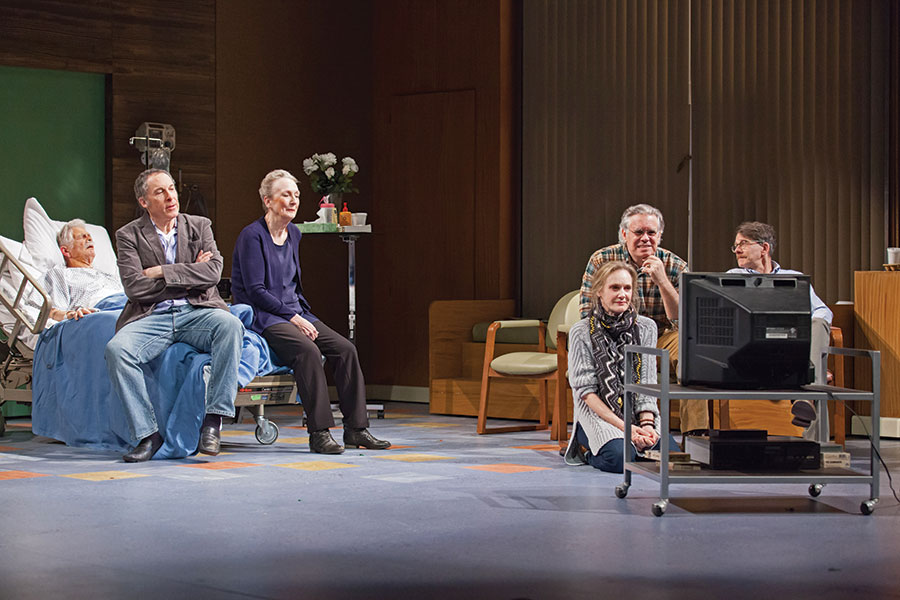
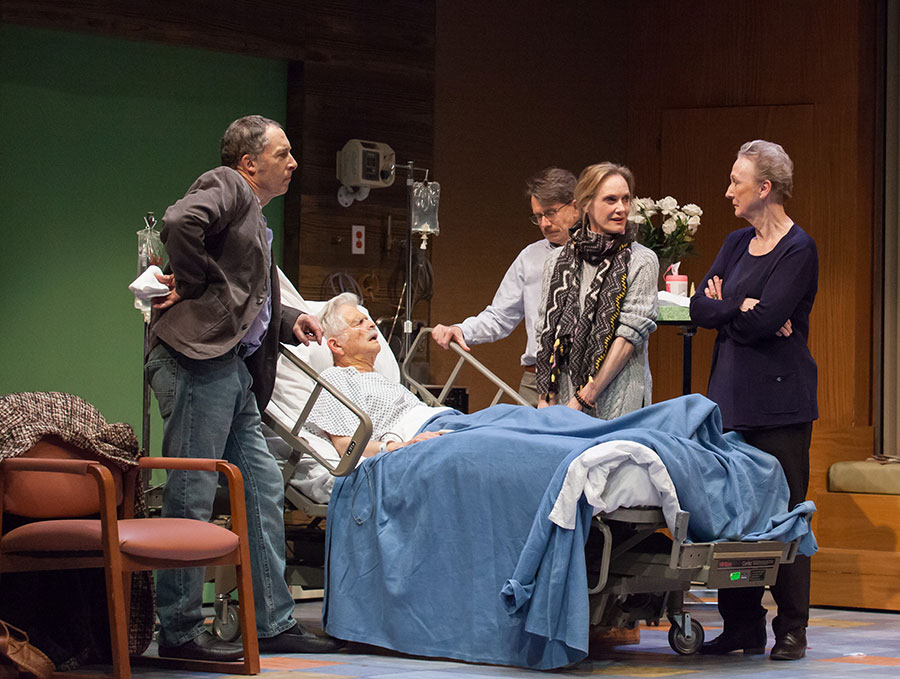
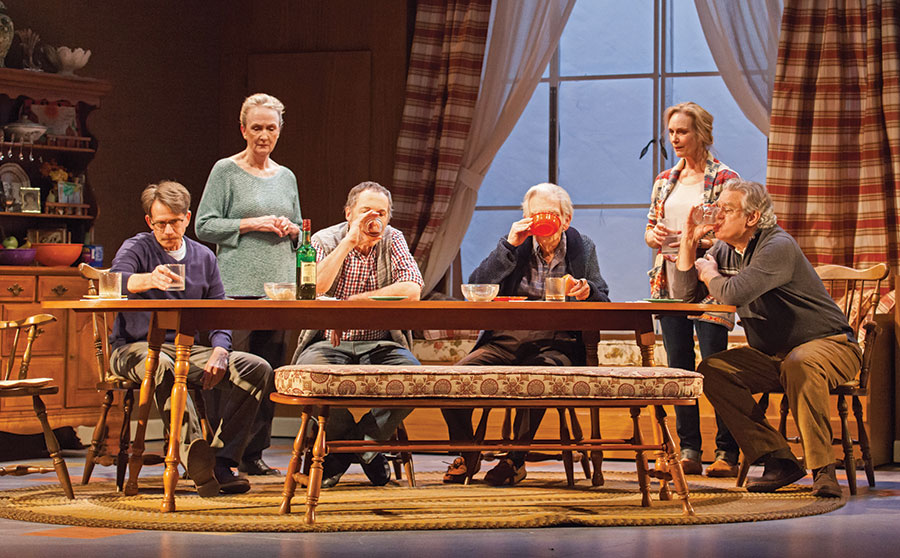
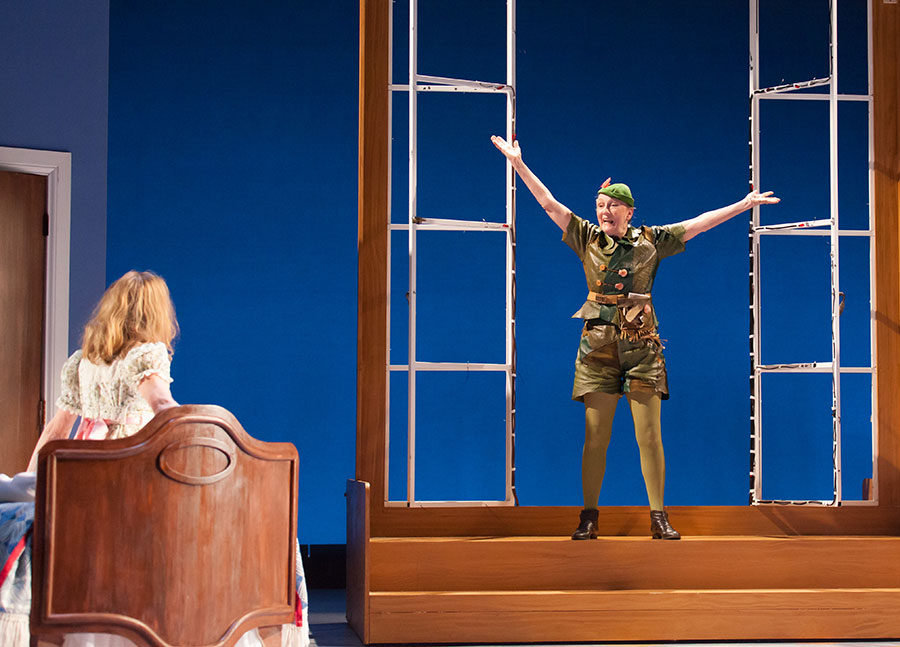

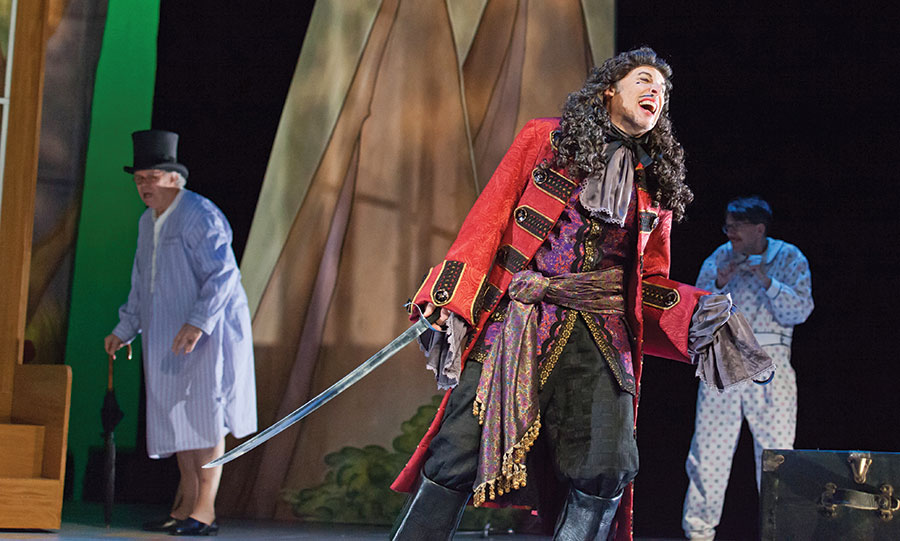
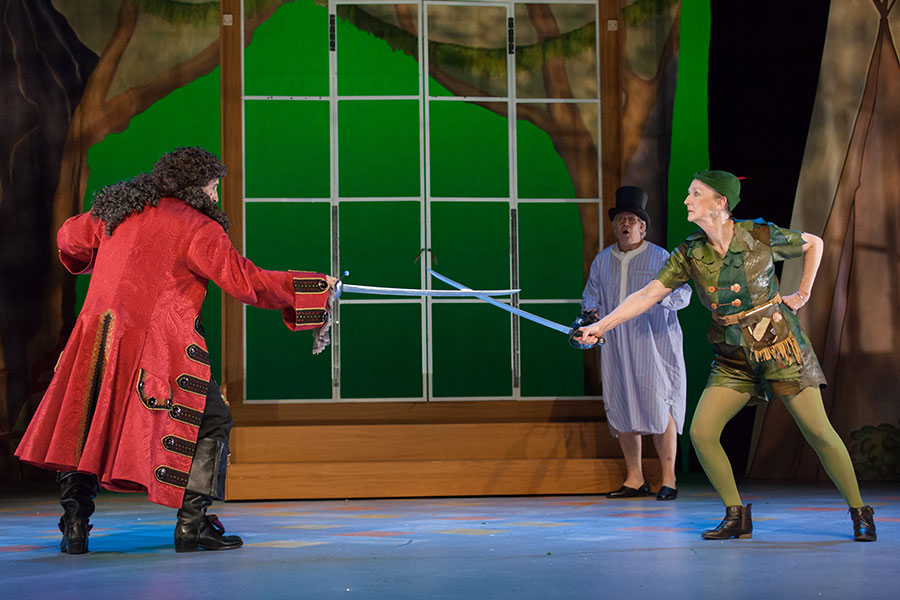
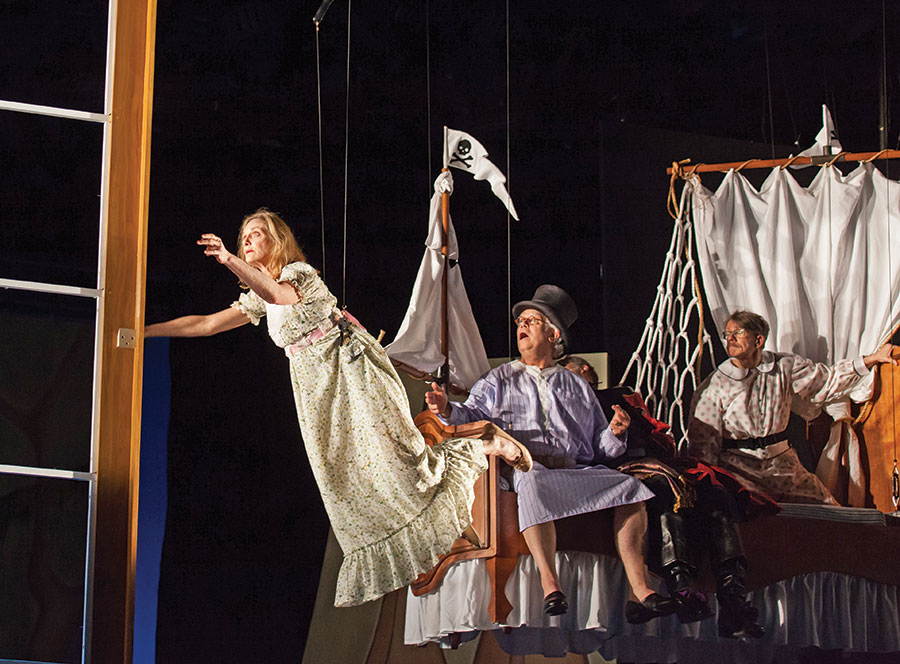
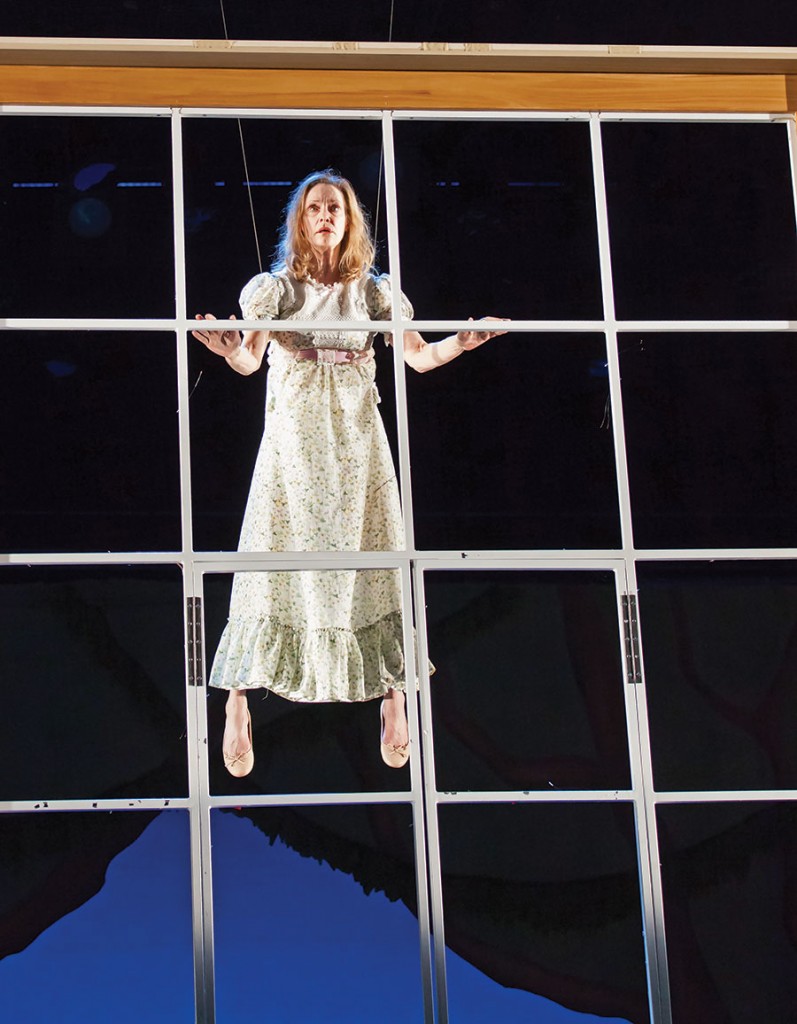
During one performance I attended, the pirate ship had a little trouble getting off the ground, and Ann-as-Peter had to urge the boys to “think lovelier thoughts” before it finally lifted up. A few minutes later, the action came to a halt as the stage manager announced that there were some “flying problems,” leaving Emery and Chalfant dangling in the air stage right, with Chandler, Jaeck, and Reddin perched on the flying bed.
A few crew members with headsets came out and stood underneath Emery and Chalfant as they were slowly brought back to the ground and unhooked from the cables, but the bed stayed aloft. It was one of those stage moments that was impossible to hide or finesse: At the most fantastical part of a fantasy, reality—and gravity—intruded.
“Anybody know a song?” Chalfant gamely offered. Someone in the audience started “When the Saints Go Marching In,” and soon the entire room—cast and crew and audience—was singing together. This unplanned reprise was the perfect choice for the moment.
In total, the action was paused for about 10 minutes; then Emery and Chalfant were rewired and the play was off again. At least one audience member I spoke to later was convinced that the entire “malfunction” was part of the play—that after going from a Midwestern dining room to full-fledged Neverland, maybe anything was possible.
After all the magic of the third section, I was surprised to hear from several audience members that their strongest reaction was to the “authenticity” of the first two movements, especially the handling of the family’s faith.
“I’m a Catholic, so I could relate to so many things,” said Suzanne Higdon, a frequent attendee of the theatre. “It was so similar to how they handle very serious moments in their lives and turn to prayer.”
“The death scene—like a lot of people, I’ve seen that room a lot of times, and it was really right on,” said Tom Hay, another Humana regular, who added that he thought the second section, set around the dinner table, was too slow.
Waters said that that second part is intentionally uneventful—that it’s meant to overturn a familiar trope of the American family drama, in which characters “get drunk and tear each other apart,” and “something will be revealed and someone will say, ‘Actually, I was abused by my father’s uncle’ or ‘I’m your mother,’ or whatever.” In Ruhl’s play, “It doesn’t—it deliberately doesn’t. It’s a reminiscence. So that is actually very tricky to play.”
Critical response was mixed though generally positive. In The New York Times Charles Isherwood called the cast and direction “superb,” particularly noting Chalfant’s delight in her role. Elizabeth Kramer at Louisville’s Courier-Journal also praised the performances and the direction, while writing that the marching band transition “disrupt(ed) the story and the mood.” Ashlie Stevens at WFPL, Louisville’s NPR station, also found that moment “cumbersome,” but thought that director Waters’s “knack for the darkly fanciful elevates Ruhl’s script.”
The delicate balance of family relationships that the actors developed would have to be adjusted for the Berkeley production, with two cast members being replaced. Speaking near the end of the Humana run, Waters said he wasn’t sure if there would be any rewrites, but he did think there would be some changes to the scene transitions.
Smart also said there would be more experiments in Berkeley with revealing the stage machinery rather than having changeovers happen behind the curtain. Owens said the theatre in Berkeley allows for slightly more room to fly, so he was hoping there would be more room for dynamic action than in Louisville’s more limited space.
For Peter Pan may have presented its production challenges, but for Ruhl it was all about audiences finding resonance with the characters and the universality of the story.
“I hope the audience brings their own personal experience to it, their own personal narrative about what it means to grow up, what it is to exist in a big family, what it means to lose the head of a big family,” Ruhl said. “The play is not a message play. I don’t think it reduces neatly that way, but I hope people connect with it emotionally.”
Chalfant certainly did. She joked in rehearsal that she would be “too old” to play the 70-year-old Ann by the time the show opened in Louisville: She just turned 71. “People who are 71 years old don’t usually get to fence and fly,” she said.
This wasn’t just Chalfant’s first time flying; it was also her first stab at swashbuckling. She has a vision problem that makes stage combat a challenge, and credits her fight partner, Chandler, with being extremely brave. “I’m almost blind in one eye, so I don’t have any depth perception,” she said with a laugh. “I can see where he is, but, you know—sort of.”
But the play’s main dimension is one Chalfant had no trouble perceiving.
“The depth of it, the fierceness of it, has been kind of a surprise that we’ve found,” she said. That sounds like a pretty grown-up discovery.
Tara Anderson is an MFA student in writing at Spalding University and contributing editor of WFPL, Louisville, Ky.’s NPR station.
*A previous version of the deck of this story erroneously reported that Sarah Ruhl’s mother was deceased. We regret the error.

